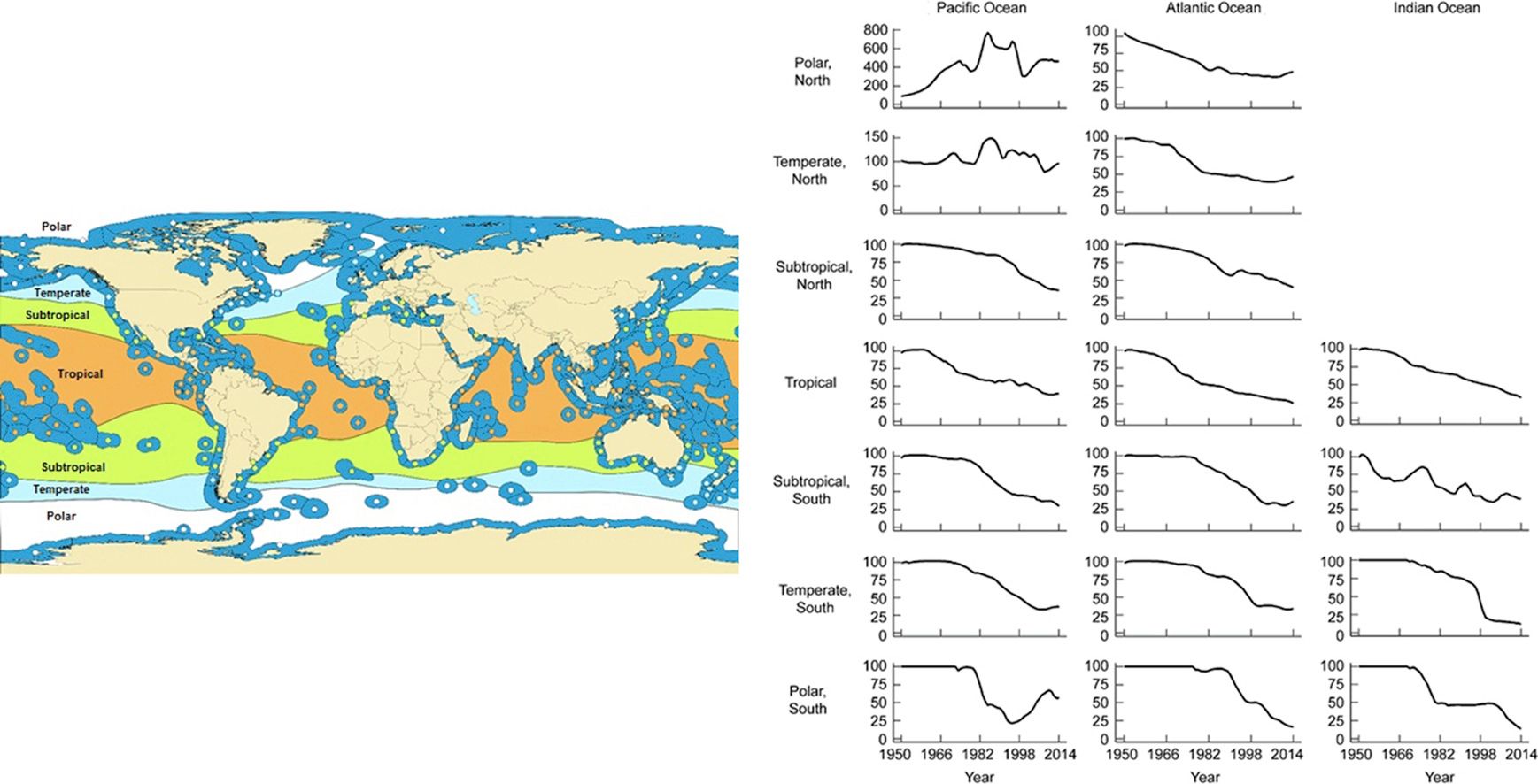The Climate #8: Playing with fire
Can our forest ecosystems survive a hotter, drier climate?
Faced with the quadruple threats of direct heat, acidification, algal bloom-induced dead-zones, and our unrelenting overexploitation; what is the prognosis for the planet's most important ocean ecosystems and fisheries, such as coral, seagrass and kelp-forest ecosystems?
As I develop the climate thread of this blog, I will try to present issues in some sort of order of importance based on the magnitude of the issue and the threat it poses to us, at least as I, with my personal biases, perceive them. The fact that global heating is baked-in, irrespective of our climate policies, for several decades to come, I view as the most important issue we need to factor into our thinking and planning for life over the next decade or two (and more). But it may come as a surprise to some readers that the impacts of our CO2 emissions on our oceans rank, to my mind, a close second.

In contrast to the issues on land, where there are important things we can and will do at a global scale to mitigate the consequences of global heating, such as changing our use of scarce land-based resources and the fact that humans can and will move and settle in different parts of the globe to some extent, most of the emerging consequences of rising CO2 emissions and global heating upon our oceans don’t appear to have such obvious, likely effective, globally scalable mitigants. What follows isn’t going to be the most uplifting read .... BUT we can at least start with the good news!
The 'good news' is that up until now and despite our abuse of them, the world's oceans have been an ally in mitigating the effects of rising CO2 emissions. For example, the world's oceans are estimated to have absorbed between a quarter and a third of all of our CO2 emissions, likely over 70 billion tons of carbon dioxide in the three decades spanning 1990-2020, mitigating the rate of rise of atmospheric CO2 by between a quarter and a third and therefore the rate of global heating itself. Even ‘better’ is the fact that as CO2 atmospheric concentrations rise, at least for now, the oceans will absorb even more CO2 per annum than ever before.*
Unfortunately though, we don’t get this mitigation of CO2 emissions by the oceans for free.
Dissolved carbon dioxide is acidic. As the oceans have absorbed more carbon dioxide, the oceans have become more acid in nature and this acid is having a profound effect on the ability of calcium carbonate shelled or skeletoned animals living in the ocean to grow the strong shells/skeletons they need to survive and thrive; be they microscopic plankton, molluscs or massive coral colonies. Destroying the ability of Foraminifera, microscopic calcium skeletoned creatures near the base of the oceanic food chain, to grow properly and weakening/retarding coral skeletal growth is unlikely to have positive consequences for oceanic food chains as a whole.
But there is another critical problem at the base of the food chain. While our valiant Foraminifera and corals are struggling, some plantlike phytoplankton that coexist with them at the base of the food chain are exploding. Warm and shallow seas, estuaries and lagoons in many parts of the globe, that are critically important human fisheries, are being invaded by summer-seasonal algal blooms. These blooms consume essentially all available nutrients and are associated with severe depletion of dissolved oxygen. By depleting the oxygen needed to survive, the blooms create what are known as ‘dead zones’ where larger creatures, including the types of fish and shellfish humans consume, can no longer live.
These dead zones are increasing in size and persisting for longer durations over the hot months of the year in more locations across the world's oceans. Perhaps the most notorious, the dead zone fronting the Mississippi delta in the Gulf of Mexico spanned some 16,000 square Km over summer 2021. With further global heating baked-in, this and other dead zones will only grow.
In terms of the most biodiverse wild fisheries that adorn and colour tropical coral reefs, the destruction of these ecologies is happening irregardless of dead zones or ocean acidification. The world's largest and most important coral ecologies are, by definition ‘tropical’, attempting to survive in warm, shallow seas near(ish) to the equator. Direct heating, particularly in the form of ocean heat waves, has already killed many important coral reefs and is certain to kill large parts of the remaining tropical coral reefs within the next decade. The Australian Government's recent pressure on UNESCO to prevent labelling the Great Barrier Reef as an ‘endangered’ world heritage site is probably fair. Quite clearly, the Great Barrier Reef has a terminal prognosis, whereas ‘endangered’ could be construed as implying there is some hope for the Reef’s recovery. There isn’t.
Similar, likely terminal, rather than merely endangering threats are affecting other productive shallow water fisheries at temperate latitudes; such as coastal sea grass beds and even further from the equator, the giant kelp forests of cool maritime regions. All three highly productive, diverse and critically important ecosystems are in decline and in some cases retreating south or north away from the equator as local temperatures warm - but only if the adjacent geography allows. Unfortunately, it is unlikely that it is feasible to transplant these complex ecosystems en masse, at a global scale, as the world’s oceans continue to warm. For tropical coral reefs in particular, if they are on your bucket list, now is literally a ‘last chance to see’.
And unfortunately, in our take everything way, we are, of course, in the process of pushing any remaining access to wild seafood over a (Seneca) cliff. Leaving aside the plastic and other toxic pollutants and local ecocidal idiocy that fails to protect these critical ecologies, the sheer plundering of the world's oceans resources over the last hundred and fifty years or so has always been and continues to be unsustainable. With a few exceptions, most of the world's important fisheries either have been or are being exploited to the point of exhaustion (see chart below).

Add to this overexploitation the triple threats of direct water warming, ocean acidification and near-coast dead zone formation, the prognosis for global wild fisheries is grim. Given that over 3 billion people depend upon fisheries as a source of dietary protein, we are looking the down the barrel of a serious and chronic global human nutrition issue.
Anyway, lets try and finish on a positive note…
Stemming the profligate flow of valuable nutrients from our farmlands into the rivers, estuaries and shallow bays where some of these algal blooms and dead zones are forming will reduce the severity of some of them. This requires actively salvaging and reusing the nutrients, of which phosphate is the most important to trap rather than squander.
Aquaculture is real and already provides more food than wild seafood capture for human consumption. Although not all aquaculture makes sense environmentally or nutritionally (scallop beds - mostly OK, prawn farming based on strip-trawled 'trash fish' meal - not so much), aquaculture can and will be scaled further - noting however that such scaling will, in many cases, be at the sacrifice of resources that could be used for more efficient food production - like, just growing and eating nutritious plants.
But, for now, if you do enjoy seafood, perhaps take the time to think about exactly what species of fish or shellfish you are eating ... and whether the fishery it came from is sustainable.
* Next century could be a different story, when warm enough, the oceans could start burping up CO2 rather than continuing to absorb it. As illustrated in the gif below...

What's the Catch is an excellent three part documentary by Matthew Evans illustrating many of the issues affecting important fisheries
Ocean acidification is covered well at ocean-acidification.net
For a short summary on the threats to coral ecosystems, try BarrierReef.org.
Subscribe to thisnannuplife.net FOR FREE to join the conversation.
Already a member? Just enter your email below to get your log in link.